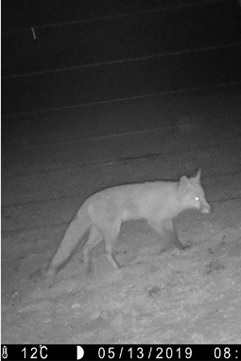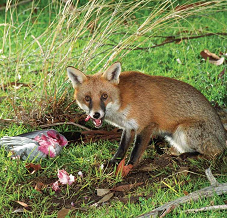 Gunning District Landcare has worked closely with South East Local Land Services to develop a sustained and strategic program to control fox numbers across the district. Foxes will always be with us but we know that if neighbours work together to eradicate foxes over a wide area then we can have a significant impact on their numbers. We have established a network of groups that undertakea two major baiting programs each year. There are often around 8,000 baits laid in the Gunning region between March and June; action on this scale has to make a difference. If your property is 10 hectares or larger, we ask you to consider joining us.
Gunning District Landcare has worked closely with South East Local Land Services to develop a sustained and strategic program to control fox numbers across the district. Foxes will always be with us but we know that if neighbours work together to eradicate foxes over a wide area then we can have a significant impact on their numbers. We have established a network of groups that undertakea two major baiting programs each year. There are often around 8,000 baits laid in the Gunning region between March and June; action on this scale has to make a difference. If your property is 10 hectares or larger, we ask you to consider joining us.
Steps for getting involved:
- Participate in a training session. Local Land Services offers regular accreditation training so you can use the necessary 1080 baits safely, ethically and effectively. These courses are offered in Goulburn and Yass, as well as other regional centres in the South East. You can find the LLS training schedule here (look for 'vertebrate pesticide training').
- Join your local area baiting group. Once you receive your accreditation, you can join your local group, and you will be entitled to a number of free baits every round of baiting. In the Gunning region there are over a dozen baiting groups, so there is likely to be one near you.
- Start baiting. Your local area group leader will contact you prior to each round of baiting to ask how many baits you would like (you are allowed to receive one bait per five hectares). LLS Biosecurity staff will drop baits off to your local area at a determined time and place. If you are unable to collect them there and then, alternative arrangements are possible. There are a number of important reminders about receiving and laying baits in this document.
 We encourage everyone engaged in pest animal management to consider using trail cameras to monitor what pest animals they have on their properties, which animals are taking baits, and how the target species is responding to your baiting program. Gunning District Landcare has a number of trail cameras for loan to members.
We encourage everyone engaged in pest animal management to consider using trail cameras to monitor what pest animals they have on their properties, which animals are taking baits, and how the target species is responding to your baiting program. Gunning District Landcare has a number of trail cameras for loan to members.
You can also contribute your fox (and other pest animal) observations to the Foxscan, and PestSmart websites.
While 1080, used strategically, is an essential element of our campaign against the fox it is not the only one. We will be adopting other control techniques over time. And there are other feral pests damaging our environment which we hope to also tackle co-operatively in the future.
Further reading:
NSW National Parks and Wildlife Service (2001) Predation by the red fox.
NSW Deptartment of Primary Industries, 'Fox control'.
NSW Department of Planning, Industry and Environment, 'Pest Animals'.


 There are some 10,000 feral foxes in the wider Gunning district. They are a huge environmental and economic menace. Foxes are an invasive introduced species that cause significant harm to stock and wildlife. Not only do they kill lambs and chickens, they also spread diseases that affect all kinds of stock – including cattle - and some native animals. Foxes have caused the extinction of many native birds, reptiles, amphibians and mammals; they are an on-going threat to numerous others.
There are some 10,000 feral foxes in the wider Gunning district. They are a huge environmental and economic menace. Foxes are an invasive introduced species that cause significant harm to stock and wildlife. Not only do they kill lambs and chickens, they also spread diseases that affect all kinds of stock – including cattle - and some native animals. Foxes have caused the extinction of many native birds, reptiles, amphibians and mammals; they are an on-going threat to numerous others.